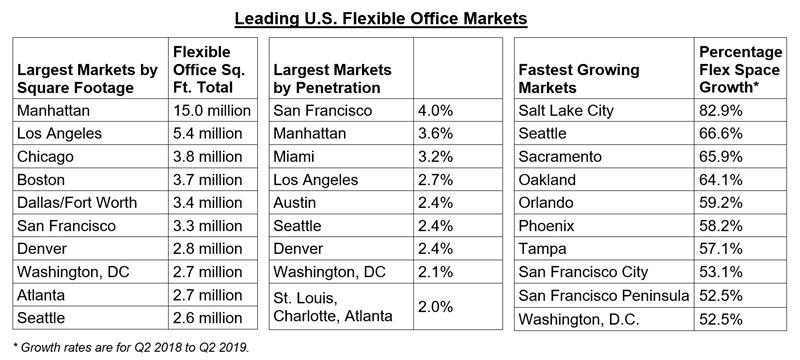| CBRE Analysis: Flexible Office Space Sector Poised For Significant Growth In The U.S., Though Operating Models May Shift
CBRE Highlights Markets with the Most Flexible Office Space, Led by San Francisco, Manhattan, Miami and Los Angeles Los Angeles – September 12, 2019—A new report from CBRE expects the U.S. market for flexible office space will generate significant growth over the next decade, even in the event of a recession, as flex operators consolidate and forge financial partnerships with building owners. CBRE outlines several growth scenarios for the flexible office space sector, which currently occupies a cumulative 71 million sq. ft., or 1.8 percent of the office space in 40 U.S. markets. CBRE’s baseline forecast calls for flexible office space to expand to approximately 13 percent of office space by 2030, reaching up to 600 million sq. ft. Even in a low-growth scenario, CBRE sees flexible office space claiming up to 6.5 percent of the market by 2030. Fueling that growth is demand from small businesses and enterprise users alike that favor the flexibility of office accommodations on relatively short-term leases, allowing them to expand or contract their space according to the needs of their business. Additionally, the flexible office space category has room to grow in every U.S. market. Even markets where flexible office space is well established – such as San Francisco at 4 percent of its office market and Manhattan at 3.6 percent – aren’t as penetrated as major international markets like London and Shanghai, both at 6 percent. “We’re seeing a fundamental change in the expectations that organizations and their employees have for the workplace. This change is spurring an increasing number of companies to engage with flexible office solutions that provide the physical environment and business terms they prefer. This shift is ongoing,” said Julie Whelan, CBRE’s Americas Head of Occupier Research. “There are some very bold predictions in the marketplace – with some calling for flexible space accounting for as much as 30 percent of office space in the future. There is simply not enough available office space to support this supply without even more drastic changes in tenant behavior.” CBRE believes flexible space can account for as much as 22 percent of office space by 2030 under the most aggressive flex-space adoption scenario. CBRE’s analysis found the majority of flexible-space supply in the U.S. concentrated in top markets, many of them tech hubs. Several of those markets also registered the fastest growth rates in the past year.
Effects of a SlowdownAn economic slowdown would naturally slow the flexible office space sector’s meteoric growth, spurring consolidation among the sector’s flex operators and a shift among the flex formats that operators and landlords use, according to CBRE’s analysis. In recent years, most flex operations were established in the traditional format of a third-party operator leasing space from a landlord. Three other formats have emerged. In the partnership model, the flex operator and landlord enter a partnership to share the operation’s profits and losses. The operating agreement model, the third-party operator runs the business for a fee from the landlord, which retains control of the space and revenue. Finally, the captive format entails the landlord operating all aspects of its flexible office space on its own. CBRE’s report posits that an economic slowdown might push more operators and investors toward a partnership model, allowing the investor to support the operator through the slowdown and then share in the upside when the economy regains strength. It could also spur some investors to consider operating-agreement or captive models, giving them more direct influence on the offering. “There are legitimate questions about how the flexible office space category will fare in an economic slowdown, when job-growth isn’t as robust. We see continued demand, though it may slow a bit from its torrid pace in recent years,” said Christelle Bron, CBRE’s Americas Agile Practice Leader. “The market’s embrace of flexible office space is a structural shift based on long-term preferences for more nimble office accommodations. That won’t be negated by a recession.” Impact on Overall Lease TermsPerhaps counterintuitively, the prevalence of flex operators in many markets doesn’t appear to have resulted in a shortening of office-lease terms there, according to CBRE’s analysis. Flex operators are signing longer-term leases, partly because market conditions favor landlords and partly because longer terms allow flex operators to spread the costs of their buildouts of the space over more years. Even so, landlords are securing fewer small-office leases of less than 5,000 sq. ft. in leading flexible office space markets. The volume of such leases declined by 8.3 percent from 2011 to Q2 2019 in the largest 10 markets for flexible office space, as compared to a 1 percent increase in all other markets. CBRE expects that flex operators will take additional marketshare in that small-office category, and that they’ll make more inroads with larger companies to employ flex space for some of their needs. Click here to download CBRE’s report for insight on these trends and more in the flexible space sector. |
||
About CBRE Group, Inc.CBRE Group, Inc. (NYSE:CBRE), a Fortune 500 and S&P 500 company headquartered in Los Angeles, is the world’s largest commercial real estate services and investment firm (based on 2018 revenue). The company has more than 90,000 employees (excluding affiliates) and serves real estate investors and occupiers through more than 480 offices (excluding affiliates) worldwide. CBRE offers a broad range of integrated services, including facilities, transaction and project management; property management; investment management; appraisal and valuation; property leasing; strategic consulting; property sales; mortgage services and development services. Please visit our website at www.cbre.com. |
70% of Executives Plan Office Expansion in 2026, With Coworking Playing a Bigger Role
Office expansion plans rise for 2026 as coworking plays a larger role.
Read more

 Dr. Gleb Tsipursky – The Office Whisperer
Dr. Gleb Tsipursky – The Office Whisperer Nirit Cohen – WorkFutures
Nirit Cohen – WorkFutures Angela Howard – Culture Expert
Angela Howard – Culture Expert Drew Jones – Design & Innovation
Drew Jones – Design & Innovation Jonathan Price – CRE & Flex Expert
Jonathan Price – CRE & Flex Expert













